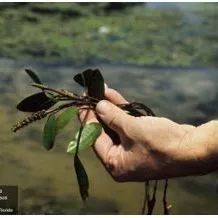Pondweeds of Florida
This factsheet describes the defining characteristics of the eleven pondweed species that are present in Florida. It serves as a pondweed identification guide for aquatic habitat managers, lake monitors, conservationists, and plant enthusiasts, and it gives some context on each species' life history and ecological role.
Pondweeds are submersed aquatic, herbaceous plants that are common in shallow water bodies across the world. Their aquatic character is written into the name of the pondweed genus Potamogeton, which originated from the Greek words for river ("potamos") and neighbor ("geiton") (Flora of North America 1993). Potamogeton is one genus of a larger order of submerged aquatic plant species that includes seagrasses and freshwater tapegrasses. Many unrelated aquatic plants may also be called "pondweed," such as horned pondweed (Zannichellia palustris) and Canadian pondweed (Elodea canadensis), but this guide focuses only on pondweeds in the family Potamogetonaceae. Pondweeds are adapted to a wide range of aquatic environments, which allows for their widespread distribution (Pip 1987). While some pondweeds can persist in saline or brackish water, most prefer freshwater and areas with slow-flowing or standing water.
Pondweeds are an important part of lake ecosystems. The structure created by pondweed shoots and leaves creates habitat and shelter for a large number of aquatic insects and fish (Berg 1949, Hayes 1974). Pondweeds also play a central role in many aquatic food webs. Plant leaves, seeds, and roots are a food source for insects, snails, fish, turtles, and waterfowl (Lagler 1943; Hayes 1974).
Additionally, pondweeds provide important functions that can improve water quality. Their leaves and shoots trap sediment suspended in the water column, which can then be held in place by their expansive root systems, leading to better water clarity (Flora of North America 1993). Pondweeds, like all plants, use nutrients to grow. In this process they can take up and store nutrients from the sediments and water column, reducing water column nutrient concentrations and thus the potential for algae blooms.
These wildlife habitat and water-quality benefits have led to pondweed restoration efforts across the globe, including in China, the Chesapeake Bay, and Lake Apopka in central Florida (Ailstock et al. 2010, Qiu et al. 2001, Reynolds and Adams 2018). On the other hand, some pondweed species can have negative consequences when growing prolifically, such as clogging water-delivery canals or impeding boat recreation. This has led to control efforts in some regions, such as in Lake Tohopekaliga, Florida (Gosselin 2016).
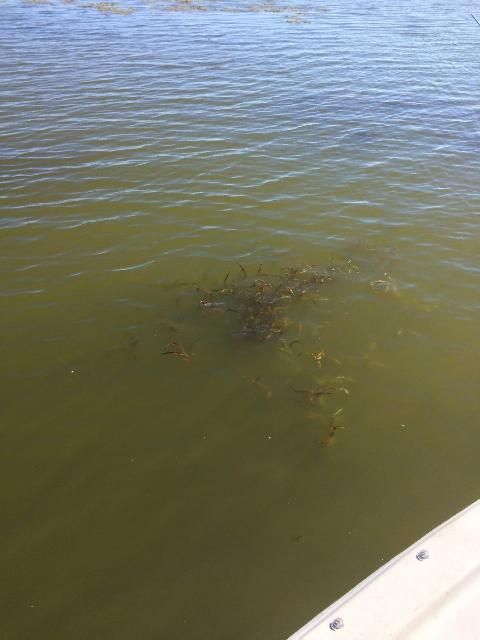
Credit: Christine Rohal, UF/IFAS
Pondweed species can be notoriously challenging to identify. They are one of the most taxonomically diverse aquatic plant groups, with as many as 100 species worldwide (Haynes and Holm-Nielson 2003). Individual pondweed species can grow to a wide range of plant heights, depending on the environmental conditions of where they are found, a characteristic called phenotypic plasticity (Kaplan 2002). In addition, other characteristics, like leaf length and width, can vary dramatically with the environment. Pondweeds are also known to frequently hybridize (Kaplan 2018), creating infertile specimens that can have some of the physical characteristics of two separate species. The diversity of pondweeds, the variability in form driven by phenotypic plasticity, and their ability to hybridize can make identification challenging to even the most seasoned taxonomists.
Pondweeds are extremely variable in their physical characteristics and growth patterns, but the eleven species present in Florida have many characteristics in common. The leaves have an alternate arrangement (see glossary for definitions of bolded terms) and have a characteristic midvein (Hellquist and Crow 1980). Most Florida pondweeds arise from thick underground stems called rhizomes, which allow them to spread outward horizontally and expand the range of a single clone (Godfrey and Wooten 1979). Pondweeds have small, inconspicuous flowers that are arranged on spikes, which typically protrude out of the water and are pollinated with the help of wind (Wiegled and Kaplan 1998). Their fruits, called achenes, are small, dry, and fused to the seed. Once achenes dehisce from the spikes, they float on currents to increase dispersal distances. All pondweeds have a thin, pointy, leaf-like appendage called a stipule, though in some species this feature quickly decomposes, while in others it remains visible throughout its lifecycle. The physical characteristics and placement of the stipule differ between pondweed species and are often used to aid identification (Figure 2).
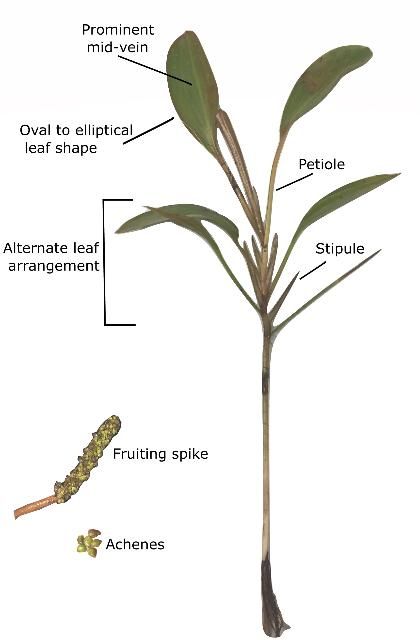
Credit: Christine Rohal, UF/IFAS
Leaf shape can vary dramatically between species, and this variation is key to pondweed identification. While some species have broad oval-, ellipse-, or lance-shaped leaves, others have more threadlike, linear leaves. Some species can have both types. While pondweeds always have submerged leaves, some species also have floating leaves, which are commonly different in form from submerged leaves. Floating leaves are often wider than submersed leaves, are typically opaque, and have a firmer, waxy texture (Cook 1996). Additionally, in some species, leaves arise from a petiole, or leaf stalk, while in other species, leaves attach directly to the stem.
Intended Audience
This guide describes eleven pondweed species that are present in Florida. While numerous species are found in Florida, many are rare or limited to few regions; one such example is Florida pondweed, which is valued for the unique diversity it brings to its region. Others, like Illinois pondweed and waterthread pondweed, are widespread, providing important habitat and water-quality benefits across Florida's diverse water bodies. Readers can use this information to identify species in their region. While some rare species are targeted for conservation, others may be the focus of control efforts (such as curly pondweed, an invasive species). It is important to correctly identify your pondweed species before conservation or management efforts are initiated.
This guide primarily focuses on the differences in vegetative characteristics across pondweed species. However, reproductive structures are often very important characteristics for taxonomic differentiation. Taxonomic keys such as Guide to the Vascular Plants of Florida (Wunderlin and Hansen 2011) and Aquatic and Wetland Plants of the Southeastern United States (Godfrey and Wooten 1979) can provide more comprehensive detail regarding these important distinctions across species.
Pondweeds with Broad, Elliptical Leaves
Illinois Pondweed
Potamogeton illinoensis
Range (United States): Widespread and common in continental United States and Canada.
Distribution in Florida: Frequent from the lower peninsula to the central panhandle. One of the most widespread Potamogeton species found in Florida.
Flowering Season in Florida: Prominent spring through fall.
Habitat: Shallow ponds, lakes, and slow-moving rivers. Can be found in a wide range of conditions but tends to prefer alkaline environments (Hoyer et al. 1996).
Conservation Status: Native, widespread.
Leaf Characteristics: Has submerged and sometimes floating leaves. Both floating and submerged leaves are broad in the middle, tapering to both ends. Leaf bases may either start at the stem or may arise on a short (up to 4 cm) petiole, or leaf stalk. Floating leaves (if present) have a sharp abrupt point at the tip. Submersed leaves are 5–20 cm long and 0.2–4.5 cm wide. Floating leaves are 4–19 cm and 2–6.5 cm wide.
Defining Features: Illinois pondweed has prominent stipules that originate on the stem distant from the leaf base. It has shorter leaf stalks and smaller, greener fruits (achenes) compared to P. nodosus, a species that otherwise has many similar characteristics. In addition, the stipules of P. illinoensis are persistent, while those of P. nodosus quickly disintegrate and are often missing from adult plants.
Fun Facts: Illinois pondweed is present across numerous nutrient-rich lakes in Florida (Hoyer et al. 1996). While this species is tolerant of moderately high-nutrient environments, excess nutrient loading (particularly phosphorus) has contributed to its decline in some lakes, such as Lake Apopka (Lowe et al. 2001).
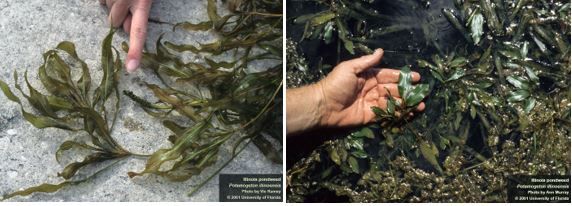
Credit: Vic Ramey and Ann Murray, UF/IFAS Center for Aquatic and Invasive Plants
Longleaf Pondweed
Potamogeton nodosus
Range (United States): Present in aquatic habitats across the United States and Canada.
Distribution in Florida: Found in Wakulla and Jackson counties.
Flowering Season in Florida: Summer.
Habitat: Lakes, ponds, and streams.
Conservation Status: Native, rare in Florida.
Leaf Characteristics: Has both floating and submersed leaves. Submersed leaves are longer than they are wide and can be linear to elliptic in shape (9–20 cm long and 1–3.5 cm wide). The floating leaves, more elliptical in shape (3–11 cm long and 1.5–4.5 cm wide), have tips that taper to an acute point. Submersed leaves have petioles that grow up to 13 cm long.
Defining Features: Can resemble P. illinoensis, but has longer petioles and larger fruits that are brown to reddish when ripe.
Fun Facts: Though another common name for this species is American pondweed, this species is actually native in Eurasia and South America as well (Ogden 1943).

Credit: Vic Ramey and Ann Murray, UF/IFAS Center for Aquatic and Invasive Plants
Claspingleaf Pondweed
Potamogeton perfoliatus
Range (United States): Found in the eastern United States and Canada.
Distribution in Florida: Specimens have been found in Polk and Wakulla counties.
Flowering Season in Florida: Spring through fall.
Habitat: Fresh or brackish water of ponds, lakes, and streams.
Conservation Status: Native, rare in Florida.
Leaf Characteristics: Only submerged leaves are present. These leaves are often thin, translucent, and somewhat oval in shape (1–7.5 cm long and 0.7–4 cm wide). Lacking a petiole, or leaf stalk, the rounded leaf base tightly clasps the stem.
Defining Features: Rounded leaf blades that clasp on stem is a unique feature, unlike other Florida pondweeds.
Fun Facts: Though this species is a pondweed, not a grass, one of its common names is "redhead grass." It may be named after the redhead, a duck that is present in Florida in winter. Redheads feed on the seeds and rhizomes of pondweeds and other aquatic plants. Claspingleaf pondweed is one of the few pondweed species in Florida that can tolerate higher levels of water and soil salinity. This species is commonly found in mesohaline water bodies with salinity levels of 5–18 ppt.

Credit: Jess Van Dyke, UF/IFAS Center for Aquatic and Invasive Plants and Donald Cameron, Go Botany
Spotted Pondweed
Potamogeton pulcher
Range (United States): Present in most of eastern North America.
Distribution in Florida: Populations found in Alachua, Leon, Jackson, and Santa Rosa counties.
Flowering Season in Florida: Spring.
Habitat: Lakes, ponds, and swamps. Prefers acid waters (Crow and Hellquist 2000).
Conservation Status: Native, rare in Florida.
Leaf Characteristics: Has both floating and submersed leaves. Floating leaves are oval-shaped with a cordate, or heart-like, leaf base (2.5–8.5 cm long and 1–4 cm wide). Submerged leaves are lance-like, narrowing towards a rounded tip, and longer than they are wide (3.5–15 cm long and 1–3 cm wide). The lowermost submerged leaves are shorter and narrower than those closer to the surface.
Defining Features: Stems have conspicuous red or black spots and can appear warty, unlike other Florida pondweed species.
Fun Facts: Another common name for this species is "heartleaf pondweed," with the heart-shaped floating leaves one of this species' most defining features.
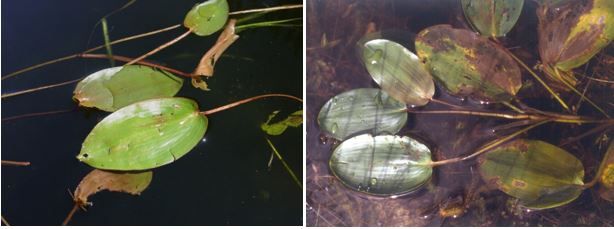
Credit: Donald Cameron, Go Botany
Pondweeds with Linear, Threadlike Leaves
Waterthread Pondweed
Potamogeton diversifolius
Range (United States): Present across most of the states in the lower 48.
Distribution in Florida: Common in the panhandle down to the central peninsula.
Flowering Season in Florida: Regularly spotted from spring through fall.
Habitat: Shallow quiet ponds, lakes, and slow-moving rivers. Sometimes found in roadside ditches. Prefers moderately alkaline waters.
Conservation Status: Native, widespread.
Leaf Characteristics: Has both floating and submersed leaves. Floating leaves are somewhat oval in shape and small (0.8–1.6 cm long and 0.3–0.9 cm wide) compared with other pondweed species in Florida. Submersed leaves are linear or threadlike (typically 1–1.3 cm long and 0.1 mm wide), very different in form from the floating leaves.
Defining Features: The floating, diminutive leaves are unlike other pondweed species in Florida; they are noticeably smaller and more oval than other species.
Fun Facts: Another common name for this species is "variable-leaf pondweed" due to the very different form of the submerged and floating leaves.
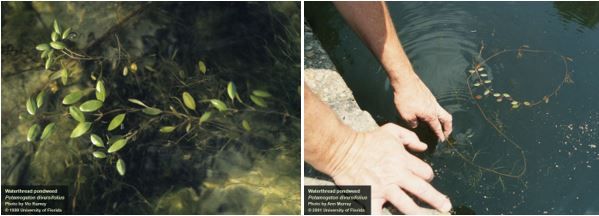
Credit: Vic Ramey and Ann Murray, UF/IFAS Center for Aquatic and Invasive Plants
Florida Pondweed
Potamogeton floridanus
Range (United States): A rare plant only present in Florida.
Distribution in Florida: Santa Rosa county in the lower Blackwater River drainage.
Flowering Season in Florida: Spring through summer.
Habitat: Rivers.
Conservation Status: Native, designated endangered in Florida.
Leaf Characteristics: Has both floating and submersed leaves. Floating leaves are elliptical, tapered at both ends, and at least 4 centimeters long. Submersed leaves are linear, are rarely more than 1 mm wide, and have no leaf stalk.
Defining Features: Can appear similar to P. diversifolius, but the floating leaves are longer and less oval in shape.
Fun Facts: Florida pondweed has been designated as an endangered plant by state and federal agencies, due to its limited range. Surprisingly, recent molecular analysis of Florida pondweed specimens revealed that it is not actually its own species, but rather a hybrid of two Potamogeton species, P. pulcher and P. oakesianus, a species that is not presently found in Florida (Kaplan et al. 2018).
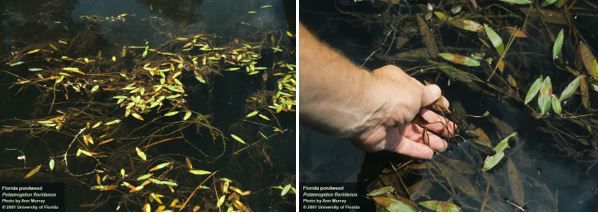
Credit: Ann Murray, UF/IFAS Center for Aquatic and Invasive Plants
Ribbonleaf Pondweed
Potamogeton epihydrus
Range (United States): Present throughout most of North America, but absent in many central states such as Oklahoma, Nebraska, and Texas. Most common in the northern United States and southern Canada.
Distribution in Florida: The only vouchered specimen is found in Escambia county.
Flowering Season in Florida: Spring through fall.
Habitat: Streams, shallow ponds. Can tolerate both alkaline and acid conditions.
Conservation Status: Native, rare in Florida.
Leaf Characteristics: Submersed leaves linear, tape-like or ribbon-like (2–10 mm wide) with parallel sides. Floating leaves are broad and elliptic on petioles that vary from short (2 cm) to quite long (12 cm).
Defining Features: Submersed, ribbon-like leaves are the most defining feature of this species, unlike other pondweed species in Florida.
Fun Facts: While this species is very common in aquatic environments in the northeastern United States, it is extremely rare in Florida, found in only one Florida county.
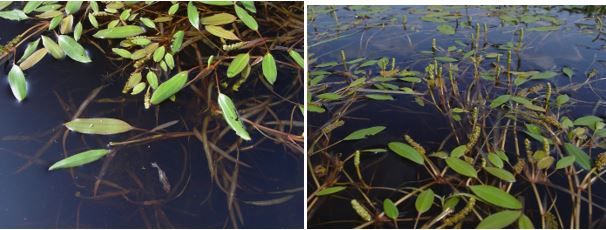
Credit: Donald Cameron, Go Botany
Small Pondweed
Potamogeton pusillus
Range (United States): Widespread across North America.
Distribution in Florida: Occasional presence throughout the central peninsula and panhandle.
Flowering Season in Florida: All year.
Habitat: Springs, small streams, lakes, and ponds. Likes alkaline conditions.
Conservation Status: Native, occasional in Florida.
Leaf Characteristics: Has only submersed leaves. Leaves are narrowly linear and slender, about 1–7 cm long, and only 0.2–2.5 mm wide. Has slender flower spikes present on submersed stems.
Defining Features: The achenes of P. pusillus have rounded edges in contrast to the achenes of the similar P. foliosus, which have tooth-like ridges.
Fun Facts: Unlike most Florida pondweeds, small pondweed has no rhizomes (thick, white, underground stems). Instead it has a fibrous root system.

Credit: Donald Cameron, Go Botany, Jess Van Dyke, UF/IFAS Center for Aquatic and Invasive Plants and Dr. John Hilty, Illinois Wildflowers
Leafy Pondweed
Potamogeton foliosus
Range (United States): Extends across North America.
Distribution in Florida: Gadsden and Santa Rosa counties.
Flowering Season in Florida: Spring through summer.
Habitat: Streams, ponds.
Conservation Status: Native, rare in Florida.
Leaf Characteristics: Has only submersed leaves. Leaf blades are narrow, linear, and tapering with acute tips (1.3–8.2 cm long and 0.3–2.3 mm wide). Leaf midribs are well defined.
Defining Features: This species can easily be confused with the more common small pondweed (P. pusillus). The biggest differences are in the achenes (seed-like fruits). The achenes of P. foliosus have prominent keels (ridges), while those of P. pusillus do not. P. pusillus has oil glands that appear as small bumps on the stems near the base of each leaf while P. foliosus does not (Hellquist and Crow 1980). In addition, P. foliosus has a thicker stalk supporting a shorter seed spike compared with P. pusillus, which has a slender long stalk supporting an elongate seed spike.
Fun Facts: Narrow, flat, more transparent leaves differ from the more rounded and opaque leaves of S. pectinata.
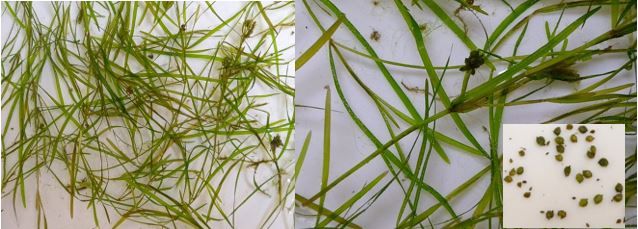
Credit: Dr. John Hilty, Illinois Wildflowers
Sago Pondweed
Stuckenia pectinata
Range (United States): A common aquatic plant across North America.
Distribution in Florida: Occasional presence in the central panhandle to the southern peninsula.
Flowering Season in Florida: Spring through fall.
Habitat: Fresh, alkaline, saline, or brackish streams, lakes, and ponds.
Conservation Status: Native, occasional in Florida.
Leaf Characteristics: Has long, slender, threadlike leaves, all of which are submerged (5.6–9.2 cm long, and 0.2–1 mm wide). Leaves are opaque, turgid (swollen), and rounded. The leaf ends in a sharp point.
Defining Features: Unlike all the other Florida pondweeds within the Potamogeton genus which have translucent and nonchanneled leaves, Stuckenia plants have opaque leaves with a deep longitudinal groove.
Fun Facts: Sago pondweed is often planted to enhance waterfowl habitat, because the fruits, tubers, and roots are desirable forage for many species (Godfrey and Wooten 1979). This has likely expanded the range of this species across North America. Sago pondweed was once classified under the genus Potamogeton but has recently be renamed Stuckenia after molecular studies confirmed its genetic separation.

Credit: Ann Murray, UF/IFAS Center for Aquatic and Invasive Plants
Non-Native, Invasive Pondweeds in Florida
Curly Pondweed
Potamogeton crispus
Range (United States): Present across the continental United States, but highest in density in the Great Lakes and surrounding water bodies as well as the Pacific Northwest.
Distribution in Florida: Present in Jackson and Seminole counties.
Flowering Season in Florida: Most frequently observed in spring through summer.
Habitat: Shallow springs and streams. Can tolerate waters with impaired water quality.
Conservation Status: Exotic, invasive. Occasional in Florida.
Leaf Characteristics: Curly pondweed has only submersed leaves. The leaves have fine, conspicuous teeth on their margins and often appear wavy. Leaves are elliptic in shape, with rounded leaf tips (blades are 1.2–9 cm long and 4–10 mm wide). The leaf bases are adjacent to the stem, with no petioles, or leaf stalks.
Defining Features: This is the only pondweed species in Florida with fine, tooth-like edges that are visible to the naked eye.
Fun Facts: Curly pondweed is native to Europe and is considered invasive in many water bodies across the United States, though it is not currently a major problem in Florida. Nevertheless, early detection and rapid response are recommended, because it can have many deleterious ecological effects. For example, it can form dense mats of vegetation that inhibit the growth of native aquatic plants and can hinder recreation and boating.
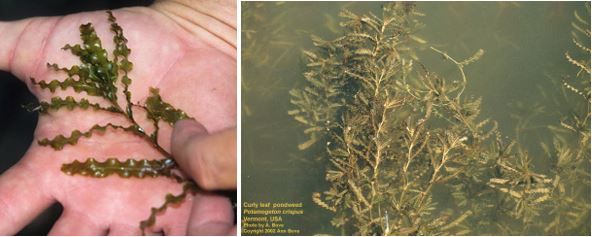
Credit: Vic Ramey and Ann Bove, UF/IFAS Center for Aquatic and Invasive Plants
Glossary of Botanical Terms
Achene: a small, dry, single-seeded fruit that remains closed around the seed
Alternate arrangement: one leaf emerges from a node, such that leaves are not opposite, or paired at the same height on a stem
Channeled: leaves with a longitudinal groove
Keel: a sharp, abrupt fold or ridge, like a keel of a boat
Lance: a leaf shape several times longer than wide, broadest toward the base and tapering toward the leaf tip
Leaf margins: the edges of a leaf, which can range from being smooth, notched, or toothed
Linear: a leaf shape that is narrow and flat with parallel sides, like a grass blade
Midvein: the main or central rib of a leaf
Petiole: the stalk that attaches a leaf blade to a stem
Rhizome: a stem, usually prostrate, that is growing below the ground surface
Spike: a flower (or fruit) arrangement that has grouped flowers that are directly attached to a stem
Stipule: a vegetative appendage that forms at the base of a petiole
Turgid: swollen or rigid
Works Cited
Ailstock, M. S., D. J. Shafer, and A. D. Magoun. 2010. "Protocols for Use of Potamogeton perfoliatus and Ruppia maritima Seeds in Large-Scale Restoration." Restoration Ecology 18:560–573. https://doi.org/10.1111/j.1526-100X.2010.00696.x
Berg, C. O. 1949. "Limnological Relations of Insects to Plants of the Genus Potamogeton." Transactions of the American Microscopical Society 68:279–291. https://doi.org/10.2307/3223270
Cook, C. K. 1996. Aquatic Plant Book (second revised edition). New York: Academic Publishing.
Crow, G. E., and C. B. Hellquist. 2000. Aquatic and Wetland Plants of Northeastern North America. Madison, WI: University of Wisconsin Press.
Flora of North America Editorial Committee, eds. 1993+. Flora of North America North of Mexico. 20+ vols. New York and Oxford. Accessed 12/18/18 at http://www.efloras.org/florataxon.aspx?flora_id=1&taxon_id=126627
Godfrey, R. K., and J. W. Wooten. 1979. Aquatic and Wetland Plants of the Southeastern United States. Athens, GA: University of Georgia Press.
Gosselin, J. 2016. "Growth and Biology of Illinois Pondweed." Graduate Dissertation and Thesis. University of Florida.
Haynes, R. R. 1974. "A Revision of North American Potamogeton subsection pusilli (Potamogetonaceae)." Rhodora 76 (808): 564–649.
Haynes, R. R., and L. B. Holm-Nielsen. 2003. "Potamogetonaceae." In Flora Neotropica, vol. 85, edited by J. L. Luteyn and S. R. Gradstein, 1–52. New York: New York Botanical Garden.
Hellquiest, C. B., and G. E. Crow. 1980. Aquatic Vascular Plants of New England: Part 1. Zosteraceae, Potamogetonaceae, Zannichelliaceaeae, Najadaceae. New Hampshire Agricultural Experiment Station Bulletin No. 515. Durham, NH: University of New Hampshire.
Hoyer, M. V., D. E. Canfield, C. A. Horsburg, and K. Brown. 1996. Florida Freshwater Plants: A Handbook of Common Aquatic Plants in Florida Lakes. Gainesville: University of Florida Institute of Food and Agricultural Sciences.
Kaplan, Z. 2002. "Phonotypic plasticity in Potamogeton (Potamogetonaceae)." Folia Geobotanica 37:141–170. https://doi.org/10.1007/BF02804229
Kaplan, Z., J. Fehrer, V. Bambasova, and C. B. Hellquist. 2018. "The Endangered Florida Pondweed (Potamogeton floridanus) Is a Hybrid: Why We Beed to Understand Biodiversity Thoroughly." PLoS ONE 13:1–20. https://doi.org/10.1371/journal.pone.0195241
Lagler, K. F. 1943. "Food Habits and Economic Relations of the Turtles of Michigan with Special Reference to Fish Management." The American Midland Naturalist 29:257–312. https://doi.org/10.2307/2420793
Lowe, E. F., L. E. Battoe, M. F. Coveney, C. L. Schelske, K. E. Havens, E. R. Marzolf, and K. R. Reddy. 2001. "The Restoration of Lake Apopka in Relation to Alternative Stable States: An Alternative View to That of Bachmann et al. (1999)." Hydrobiologia 448:11–18. https://doi.org/10.1023/A:1017541010768
Ogden, E. C. 1943. "The Broad-Leaved Species of Potamogeton of North America North of Mexico." Rhodora 45:119–163.
Pip, E. 1987. "The Ecology of Potamogeton Species in Central North America." Hydrobiologia 153:203–216. https://doi.org/10.1007/BF00007207
Qiu, D., Z. Wu, B. Liu, J. Deng, G. Fu, and F. He. 2001. "The Restoration of Aquatic Macrophytes for Improving Water Quality in a Hypertrophic Shallow Lake in Hubei Province, China." Ecological Engineering 18:147–156. https://doi.org/10.1016/S0925-8574(01)00074-X
Reynolds, L., and C. R. Adams. 2018. Characterization of the Efficacy of Bubble Curtains in Enhancing Submerged Aquatic Vegetation in Lake Apopka. Final Report to the St. Johns Water Management District. Contract 30247.
USDA–NRCS. 2018. The PLANTS Database. National Plant Data Team, Greensboro, NC 27401-4901 USA. http://plants.usda.gov
Wiegleb, G., and Z. Kaplan. 1998. "An Account of the Species of Potamogeton L. (Potamogetonaceae)." Folia Geobotanica 33:241–316. https://doi.org/10.1007/BF03216205
Wunderlin, R. P., B. F. Hansen, A. R. Franck, and F. B. Essig. 2018. Atlas of Florida Plants. [S. M. Landry and K. N. Campbell (application development), USF Water Institute.] Institute for Systematic Botany, University of South Florida, Tampa. http://florida.plantatlas.usf.edu/
Wunderlin, R. P., and B. F. Hansen. 2011. Guide to the Vascular Plants of Florida. Third Edition. Gainesville: University Press of Florida.



